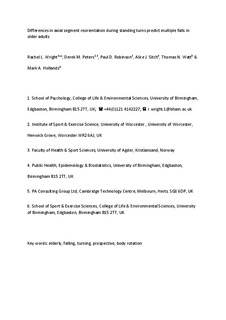| dc.contributor.author | Wright, Rachel L. | |
| dc.contributor.author | Peters, Derek M. | |
| dc.contributor.author | Robinson, Paul D. | |
| dc.contributor.author | Sitch, Alice J. | |
| dc.contributor.author | Watt, Thomas N. | |
| dc.contributor.author | Hollands, Mark A. | |
| dc.date.accessioned | 2013-02-04T09:49:02Z | |
| dc.date.available | 2013-02-04T09:49:02Z | |
| dc.date.issued | 2012 | |
| dc.identifier.citation | Wright, R. L., Peters, D. M., Robinson, P. D., Sitch, A. J., Watt, T. N., & Hollands, M. A. (2012). Differences in axial segment reorientation during standing turns predict multiple falls in older adults. Gait and Posture, 36(3), 541-545. doi: 10.1016/j.gaitpost.2012.05.013 | no_NO |
| dc.identifier.issn | 0966-6362 | |
| dc.identifier.uri | http://hdl.handle.net/11250/139035 | |
| dc.description | Author's version of an article in the journal: Gait and Posture. Also available from the publisher at: http://dx.doi.org/10.1016/j.gaitpost.2012.05.013 | no_NO |
| dc.description.abstract | Background: The assessment of standing turning performance is proposed to predict fall risk in older adults. This study investigated differences in segmental coordination during a 360° standing turn task between older community-dwelling fallers and non-fallers. Methods: Thirty-five older adults age mean (SD) of 71 (5.4) years performed 360° standing turns. Head, trunk and pelvis position relative to the laboratory and each other were recorded using a Vicon motion analysis system. Fall incidence was monitored by monthly questionnaire over the following 12 months and used to identify non-faller, single faller and multiple faller groups. Results: Multiple fallers were found to have significantly different values, when compared to non-fallers, for pelvis onset (p=. 0.002); mean angular separation in the transverse plane between the head and trunk (p=. 0.018); peak angular separation in the transverse plane between the trunk and pelvis (p=. 0.013); and mean angular separation between the trunk and pelvis (p<. 0.001). Conclusions: Older adults who subsequently experience multiple falls show a simplified turning pattern to assist in balance control. This may be a predictor for those at increased risk of falling. | no_NO |
| dc.language.iso | eng | no_NO |
| dc.publisher | Elsevier | no_NO |
| dc.subject | elderly | no_NO |
| dc.subject | falling | no_NO |
| dc.subject | turning | no_NO |
| dc.subject | prospective | no_NO |
| dc.subject | body rotation | no_NO |
| dc.title | Differences in axial segment reorientation during standing turns predict multiple falls in older adults | no_NO |
| dc.type | Journal article | no_NO |
| dc.type | Peer reviewed | no_NO |
| dc.subject.nsi | VDP::Medical disciplines: 700::Health sciences: 800 | no_NO |
| dc.source.pagenumber | 541-545 | no_NO |
| dc.source.volume | 36 | no_NO |
| dc.source.journal | Gait and Posture | no_NO |
| dc.source.issue | 3 | no_NO |
| dc.identifier.doi | 10.1016/j.gaitpost.2012.05.013 | |
